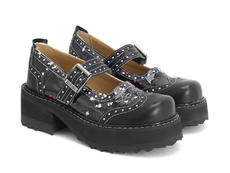Podiatrist Recommended
John Fluevog Women's Shoes
John Fluevog Women's Shoes
Supervog
Akira
Todne
Flame
Capellan
Find
Advisor
Virtue
Luxon
Zenobia
These John Fluvog shoes are a great choice for anyone looking for comfortable yet fashionable footwear. I would recommend that you go to a Fluevog store to try on the shoes if at all possible. If you order online, I recommend that you read the reviews because it will give you tips on getting the best sizing.
To review, for any shoe to be good enough for your feet it must meet 4 criteria:
First, the most important thing to remember is that any shoe that you wear must have a thick, rigid and non-flexible sole.
The concept is counterintuitive but the idea is that if you have a painful joint then the last thing that you want to do is wear flexible shoes that force motion through joints that can’t handle it. When it comes to the foot, less motion equals less pain, inflammation and joint damage. A sturdy sole with no motion will also stop or slow the progression of bunions, hammertoes, stress fractures, and osteoarthritis.
Second, it is important that it has a soft, wide toe box, which will put less pressure on toes, which helps to prevent corns, ingrown toenails and will even decrease the risk of developing toenail fungus.
Third, all shoes that you wear should have rearfoot control because shoes without rearfoot control force you to scrunch down your toes to stay in the shoe, which promotes hammertoes and mechanical strain on your tendons and ligaments, which can cause tired leg syndrome.
The fourth thing is to wear shoes that will accommodate a custom-molded orthotic or an excellent over-the-counter insert for better arch support, which will help with preventing knee, hip and even lower back pain. If your dress orthotics don't work in your dress shoes or heels then don't wear them as trying to force them into a dress shoe can cause problems such as discomfort, calluses, and crowding of toes. Of the four criteria listed here, having arch support is the least important of the four.
These shoes are not recommended for patients with:
*Diabetes
*Peripheral Neuropathy (nerve damage)
*Peripheral Arterial Disease (poor circulation)
*History of foot ulcerations
*Charcot Foot
If you are unsure if any of these shoes will work for your foot condition, please refer to your local podiatrist.
I hope this was helpful!
Dr. Cathleen A. McCarthy
:)
These shoes are not recommended for patients with:
*Diabetes
*Peripheral Neuropathy (nerve damage)
*Peripheral Arterial Disease (poor circulation)
*History of foot ulcerations
*Charcot Foot
If you are unsure if any of these shoes will work for your foot condition, please refer to your local podiatrist.
I hope this was helpful!
Dr. Cathleen A. McCarthy
:)























